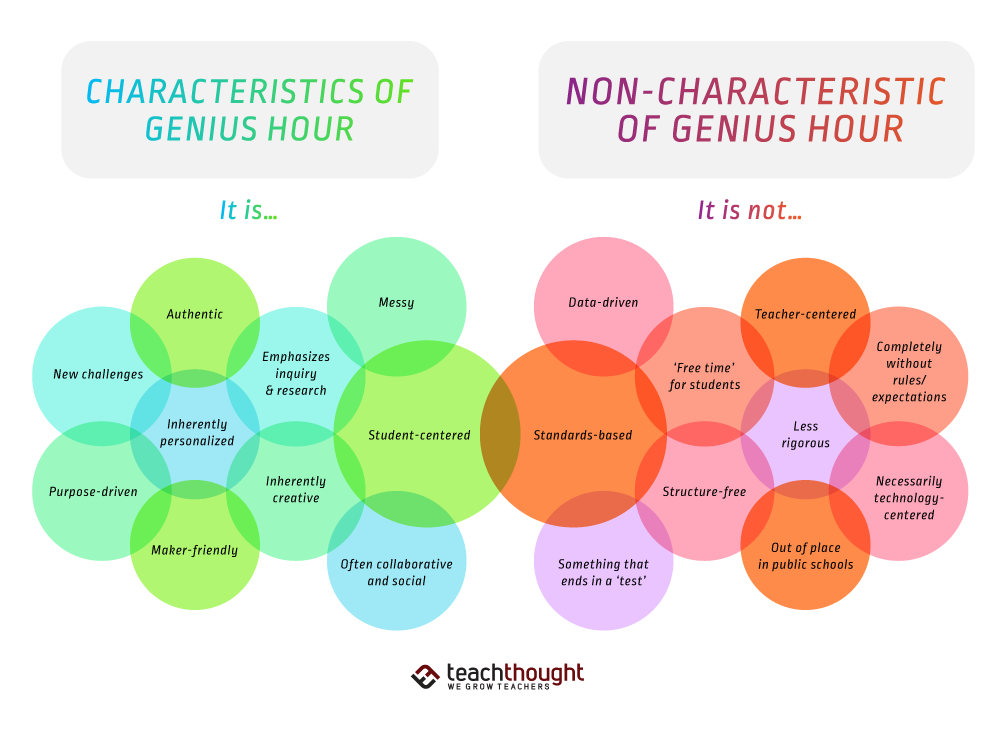An Overview Of Genius Hour
by TeachThought Staff
Genius Hour is an approach to learning where students are guided by their own interests, background knowledge, and curiosity to learn.
From the outside looking in, it is less organized, less formal, and less standardized than traditional learning. Genius Hour is truly ‘open-ended’ learning characterized by student self-direction, passion-based learning, inquiry, and autonomy.
In public education, Genius Hour can be thought of as a response to rigid, test-driven, and ‘achievement-focused’ climate that the testing-based model of school improvement has encouraged in schools over the two or three decades. It allows (actually, it requires) students to explore their own ideas and follow their own instincts in learning for the sake of learning, creating for the sake of creating, and doing for the sake of doing. An underlying assumption of genius hour is that if students are given space and tools and audiences and time, they will create something personal and compelling, and of course be ‘learning’ in the process.
It has several unique characteristics that separate it from other approaches to education.
As we said in Principles Of Genius Hour, Genius Hour is most notably associated with Google, where “employees are able to spend up to 20% of their time working on projects they’re interested in and passionate about. The study and work are motivated intrinsically, not extrinsically. The big idea for Google is that employees motivated by curiosity and passion will be happier, more creative, and more productive, which will benefit the company in terms of both morale, ‘off genius productivity, and ‘on genius’ performance.”
See also 20 Tips For A More Organized Classroom
The idea here is that teachers engage and empower students by connecting them with the ideas and content and opportunities themselves by allowing them to pick something they want to learn more about, do, or accomplished, and then do exactly that following their curiosity through inquiry and research.
Characteristics of Genius Hour
It is…
- Student-centered
- Messy
- Emphasizes inquiry and research
- Authentic
- New challenges (i.e., it creates new problems to solve in your classroom)
- Inherently personalized
- Inherently creative
- Purpose-driven
- Maker-friendly
- Often collaborative and social
Non-Characteristics of Genius Hour
It is not…
- Standards-based
- Data-driven
- ‘Free time’ for students
- Teacher-centered
- Without any rules or expectations
- Less rigorous (compared to other approaches to learning)
- Structure-free
- Requires whiz-bang technology
- Out of place in public schools and other formal learning environments
- Something that ends in a ‘test’
One Approach: Three Basic Rules for Genius Hour
One of the key elements of Genius Hour is its lack of specific rules and dependence on intrinsic motivation. This approach is about the student, their curiosity, and their autonomy–factors that (ideally) will support the students in doing their best work, and creating something wonderful and personalized that the teacher would not have been able to imagine and plan on their own.
This means that the role of the teacher, the presence of rules, and the function of any structure or framing of the learning experience can make or break its effectiveness. The more rules you have, the less likely it’s actually Genius Hour.
- It should be driven by student curiosity and might use a clear driving question to guide inquiry
- It should involve research or clear ‘new learning’
- The product, end result, or other compelling artifact from the project can be shared/published
These are rules based on one teacher’s approach in one class in one district with a specific set of technology access, student engagement, etc. Which means your rules might be different than these–or you might start out with these, then change one or two based on how it goes, specific related goals in your school or district, and so on.
You can find a video that explains more about genius hour here.
What Is Genius Hour?
